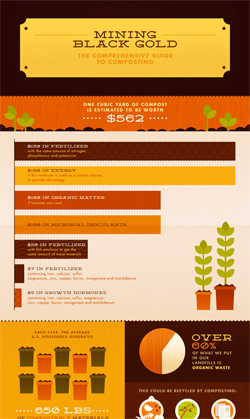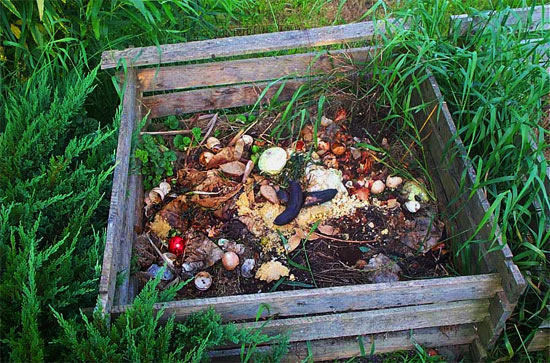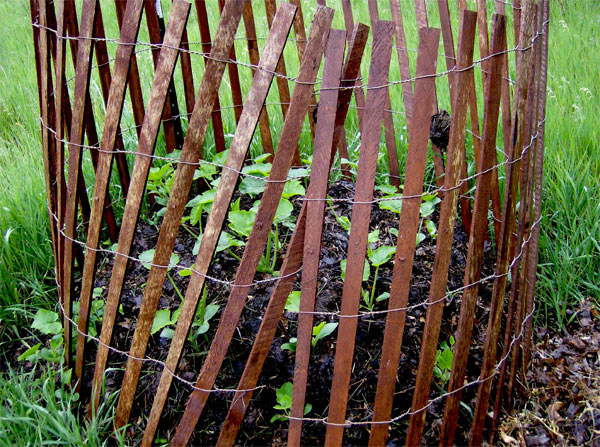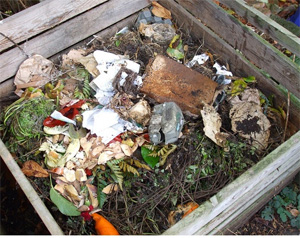A key ingredient to any healthy garden is soil. Loam, which consists of relatively equal parts sand, silt, and clay, is preferred because it drains well, breaks apart easily, and maintains moisture and nutrients. Many garden plots do not have ideal soil and require the addition of organic material in order to provide nutrients for healthy plants and make the soil easier to manage. Compost is an inexpensive, environmentally-friendly way to turn your waste into nutrients that help balance out the sand, silt, and clay ratio in your garden.
Setting up a compost pile or bin is easy. It doesn't take much space. All you need is a space that is three feet high, wide, and deep for a small composting operation. For larger operations, you might want to have more than one area. Your compost area can just be a pile or you can build or purchase a bin. Bins can be made of chicken wire, wood, concrete block, or straw bales. You can also buy a plastic bin or tumbler to make turning your material easier.
Before you start composting, it is important to understand that a successful compost pile requires the appropriate carbon to nitrogen ratio. Two-thirds of your compost material should be carbon rich: dried leaves, woody material, paper, ash, straw or hay, pine needles, egg shells. Carbon-rich materials keep the compost material light and fluffy and helps ward off bad smells. Nitrogen rich material such as manures, food scraps, and green plant material should not make up more than one third of your compost material.
Do not use meat or bones in your compost pile. While both carbon and nitrogen sources are important for good compost, you should err on the side of adding too much carbon sources to ensure that your compost pile "digests" quickly and produces a rich, fluffy material.
 A very nice info graphic on composting
A very nice info graphic on compostingby Aldo Baker at Fix.com.
Click image to see it all!
Now that you have a compost area and know what materials you need, the next step is to start bringing together the ingredients. Start your pile on bare earth. This will allow beneficial organisms to enter your pile and aid in the decomposition process. Add a layer of straw or twigs. This layer will allow air to enter the bottom of your pile. Once you have completed the first two steps, start adding your carbon and nitrogen items in layers. Each layer can be several inches thick.
Maintaining your compost pile is as simple as ensuring it keeps a proper moisture level and turning it every two to four weeks. Compost should be kept moist to keep the pile decomposing. If you live in a wet area, you will want to cover your compost pile to make sure it does not become over saturated. Aside from occasional watering, you will also need to turn the pile every two to three weeks with a shovel or pitchfork to allow oxygen into the pile so it can continue to break down. When turning the compost pile, try turn it so the outside edges are turned into the center and the center material is brought to the outside.
The length of time to turn your waste into compost depends on a variety of factors. Moisture content, how often the pile is turned, temperature, and ratio of carbon to nitrogen materials all effect composting time. Generally, a compost pile that is turned frequently can produce quality compost in about three months.
When your compost is ready, you can use it as a soil additive or mulch. To use it as a soil additive, add 3-4 inches of compost over your garden soil, then till it to a depth of six inches or so.
Compost Pile Designs

Using wood slats to build a square bin.
Image from theDailyGardener.com.

Using a snow fence for a compost pile.
Image from MyNorth.com.

Even free sticks and branches can be used.
Image via Flickr & Bryan Alexander.
